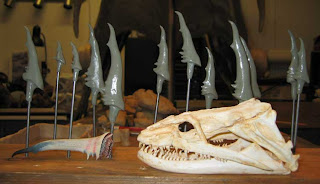We were out on a trip to the pet cemetery to visit the cats' graves and while we were getting the flowers out of the the car I heard what sounded like geese. That was odd since I didn't recall there being any water around the pet cemetery.
Sometimes geese fly overhead, and we looked around but nothing. The noise got louder and louder, and it sounded like hundreds of geese. Where were they?
Finally, maybe a thousand feet up in the air, we saw these tiny dots like dust specks swirling about and sometimes forming huge v's. These were the geese!
It was not just mesmerizing, but supernatural. Wave after wave of groups of screaming geese swept over us at that thousand feet (or more?) heights. Tens of thousands of geese, each group calling to one another and the sounds drifting down to us. It went on for most of twenty minutes until we finally left the cemetery - but it may have been going on for hours.
One other weird thing, too. Below the geese, perhaps only a few hundred of so feet up, there were at least a dozen turkey vultures circling. It seemed obvious, they were awaiting a tired goose to fall out of the sky so they could pounce on the crushed feathered body. We saw at least one hawk, too.
All in all, this was a weird and powerful experience.
Saturday, November 28, 2009
Monday, September 14, 2009
Monarch Migration at Bernheim Forest (KY)
Mr. Bruggers, I apologize.
I meant no disrespect, and here is the link. I have removed the rest of the text and images.
http://www.courier-journal.com/article/20090913/GREEN/909130344/1008/NEWS01
Please visit Mr. Bruggers article.
Volunteers track monarch migration as population shrinks
By James Bruggers • jbruggers@courier-journal.com • September 13, 2009
Monarch butterflies glide and soar like hawks ... more ...
I meant no disrespect, and here is the link. I have removed the rest of the text and images.
http://www.courier-journal.com/article/20090913/GREEN/909130344/1008/NEWS01
Please visit Mr. Bruggers article.
Volunteers track monarch migration as population shrinks
By James Bruggers • jbruggers@courier-journal.com • September 13, 2009
Monarch butterflies glide and soar like hawks ... more ...
Is the Loch ness Monster a Real Eel?





Steve Alten, a native of Philadelphia, holds a Bachelors degree in Physical Education from Penn State University, a Master in Sports Medicine from the University of Delaware, and a Doctorate degree in Sports Administration from Temple University. His first book, MEG; A Novel of Deep Terror was a N.Y.Times bestseller and was sold in more than a dozen countries.
I had no idea about any of his Loch Ness (real life) theories until I heard him on George Noory the other night. He's spent much time and money trying to figure out the Loch Ness mystery.
His opinion is based on a theory that Sargasso Sea species of eel has for millenia been carried by sea currents into inland water systems of Great Britain. It's true and many specimens have been found. Steve himself apprently posted a bounty for evidence, and a tooth of an eel was found in a half-eaten deer carcass on an island of a small lakelet. That tooth was huge, and allegedly this model is based on that tooth or one like it.
Eels do not die unless they spawn. However, lake-locked eels cannot spawn unless they can escape and swim back to Sargasso spawing grounds. Otherwise they live much over 100 years, and continue to grow as they eat.
They love dark, deep, cold water - and thus Loch Ness is an ideal area - plenty of food, lenty of deep, dark, cool water.
And they have teeth. And they are amphibious and can not only crawl on land, small eels can climb trees like a snake. There is no escape once they latch onto "food" which could include peoples. Eek.
These are images that folks associated with Alten have found and formed. Be afraid of the dark waters - be very afraid.
Subscribe to:
Comments (Atom)


